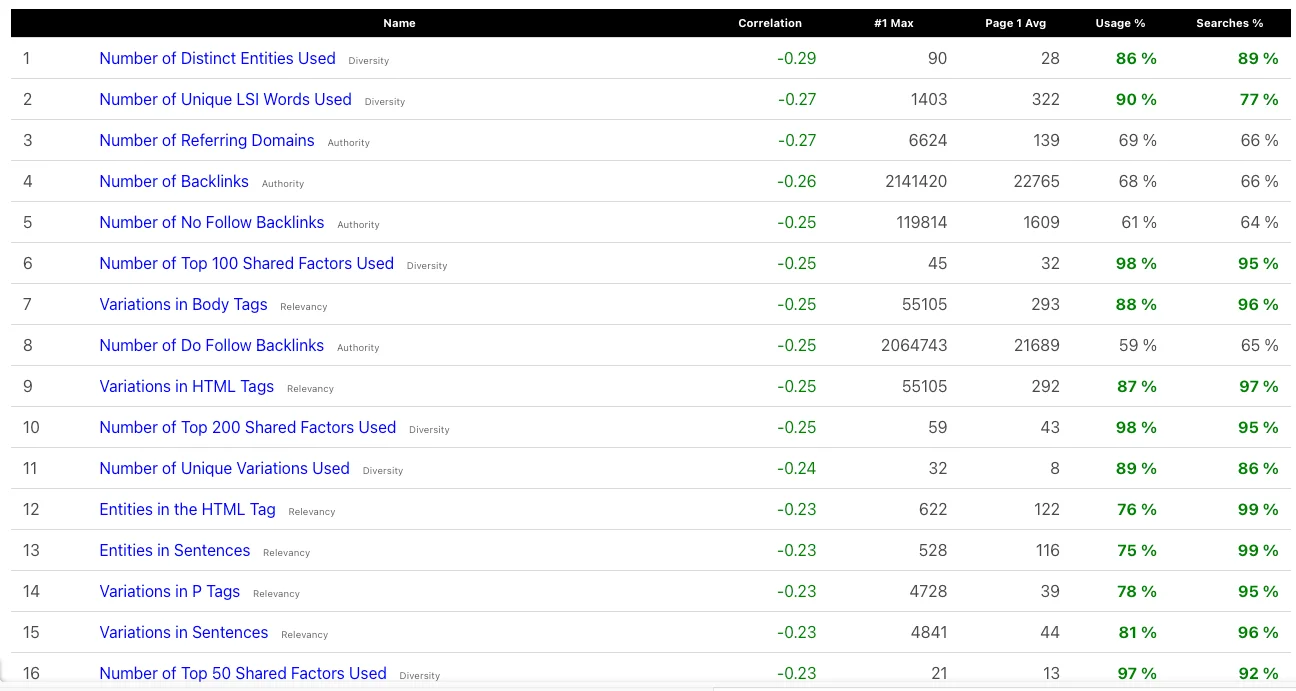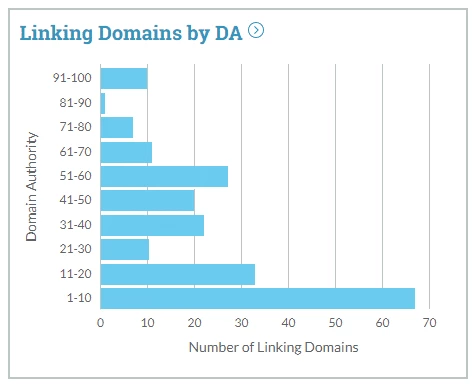Toxic Backlinks: How to Tell if My Backlinks Hurting My SEO?
.jpg)
While the impact of backlinks is slowly waning, it still remains one of the most correlated ranking factors in Google's algorithm.
Backlinks are listed as number 3, 4, 5 & 8 on the most correlated list of ranking factors for SEO.[/caption]
So how do you know if your backlinks are hurting your SEO? In this article, we’ll explore some signs that may indicate that you have ineffective or even harmful or toxic backlinks.
We'll also offer strategies for removing bad or toxic links to improve your overall SEO performance.
Characteristics of a Toxic Backlink Profile

Toxic backlinks (aka unnatural links) can be identified by a few key characteristics.
Low Quality Source
Firstly, these links often come from poor-quality websites, as opposed to websites that have good domain authority and reliability.
The content of the website may also become spammy sites or contain inaccurate information.
Additionally, toxic backlinks are usually created in bulk and not naturally acquired; however, it’s still important to look out for unnatural patterns of acquisition.
High, Unnatural Link Velocity
Link velocity is the measure of the number of links you acquire over a period of time.
If you are able to acquire 10 links this month and then 10,000 links next month, would it look natural?
Only in the case of a viral content share, but that is typically more rare. Viral link acquisition still typically maintains a normal distribution of links from varying sources and IP addresses when you gain links.
If you combine spam sites or toxic links with high link velocity, it can make for a double-whammy against your site's SEO.
Links from Generic Sources
Do you have toxic incoming links from a site that has every content category under the sun and every post uses some type of commercially-focused money term?
Perhaps your post is nestled on the site between a payday loan post and one about CBD?
Does the written content on the site on which you are posting match
Links from PBNs
The profile of a PBN (private blog network) is fairly easily detected.
Things like similar or exact match IP addresses to other sites and inbound links to outbound link ratios are pretty obvious.
Private blog networks (PBNs) also tend to be built for the sole purpose of outbound link procurement.
Many PBN sites are often repurposed domain names, acquired from droplists or auctions. The new content has nothing to do with the original site and is built for the sole purpose of passing along link equity.
Paid Links
Paid links are often considered a shortcut to boosting SEO. After all, they’re sponsored content, and the search engine results pages generally reward websites for having high-quality content. Conducting a backlink audit can help identify and address any paid links that may be negatively impacting your site's SEO.
However, it’s important to understand that sponsored links can actually harm SEO if they’re not used strategically. Here’s what you need to know about these toxic link schemes and how they can manipulate search engine rankings and hurt your SEO efforts:
Google, Bing, and other search engines have strict policies against aggressive spam link building. They consider this type of link building a form of manipulation, which is why it’s strongly discouraged and often penalized.
In addition, paid backlinks can quickly become outdated and irrelevant if the content changes or the website goes away. This will result in a poor user experience, which could lead to a penalty from search engine.
Finally, many paid or sponsored placements are low-quality and have little relevance to your website or industry, which can also lead to a penalty, unlike trustworthy sites.
The bottom line is that paid or bought links can be hazardous to your SEO efforts if they’re not used correctly. It’s best to avoid them altogether, or take the time to vet any potential link partners thoroughly before making an agreement. This might involve identifying and disavowing link schemes and potential toxic links.
Characteristics of a Quality Backlink
A quality backlink profile has the following key characteristics:
1. It's Diverse
A quality backlink profile will be diverse in its authority and most often look something like this:

Not like this:

2. It includes natural anchor text
If all your link anchor text includes things like "Los Angeles car accident lawyer" then it's pretty obvious what stunts you're trying to pull.

3. Natural link placement
Links from sources where you're acquiring sitewide links or links from another site's homepage are not natural and will likely be penalized.
How Toxic Backlinks Can Harm Your SEO
Backlinks can be great for SEO, but when they become toxic, the consequences can be severe. Here are some of the ways that toxic backlinks can hurt SEO:
1. Penalty from Search Engines
The most immediate consequence of toxic backlinks is a penalty from search engines.
If search engine algorithms detect too many unnatural or low-quality links pointing to your website, this can lead to a manual or algorithmic penalty which will significantly reduce your rankings in the SERPs. Google's newly released SpamBrain algorithm is one particular example of a tool that can detect and penalize websites with toxic backlinks.
Most of today's penalties are delivered algorithmically, which means they're likely not penalties at all. In most cases, you just need to clean up your act, remove and/or disavow bad links and continue updating and/or creating new quality content that search engines will love.
2. Poor User Experience
Low-quality links can also lead to a poor user experience, which search engines take into account when ranking websites. If visitors are being directed to irrelevant or malicious websites through your backlinks, it will signal to search engines that your website isn’t providing an optimal user experience.
3. Negative Brand Perception
Toxic backlinks can also damage your brand’s reputation, making it difficult for new potential customers to find and trust you.
If your brand is associated with websites containing spam or malicious content, this can lead to a negative perception from the public at large.
Protect Your Website from Toxic Backlinks
Fortunately, there are ways to protect your SEO from toxic backlinks. Here are some tips:
1. Monitor Your Backlinks Regularly
It’s important to keep an eye on the quality of your backlinks by periodically checking them for any changes or issues.
We recommend a backlink audit be performed at least once each quarter.
You should also be aware of the websites that are linking to you and make sure they are credible sources. This can fix toxic backlinks.
2. Use a Backlink Cleanup Tool
If you’ve identified some toxic backlinks that need to be removed, there are tools available that will help you do this.
These tools can also be used to identify bad links in the first place, helping you stay ahead of any potential issues.
We recommend one of the following:
- Linkody
- rmoov
- Monitor Backlinks
- Linkquidator 2.0
- Remove’em
4. Disavow Poor Quality Links
Submit removal requests, nasty-grams or even "cease and desist" requests to remove toxic backlinks from nefarious sources.
3. Disavow Poor Quality Links
If you’ve identified some links that are beyond repair, the best course of action is to disavow them in Google Search Console (GSC).
This means telling search engines not to take them into account for SEO purposes, which may help prevent any penalties from being issued.
While Google has said that they typically ignore bad backlinks, the data tells us that there is a certain level of toxicity in backlinks that can drastically harm your SEO efforts.
Stay Vigilant
Overall, backlinks are a powerful tool for SEO and overall search engine rankings, but it’s important to use them responsibly. By keeping an eye on the quality of your backlinks and taking action when necessary, you can ensure that they are helping rather than hurting your SEO efforts.
Backlinks play an important role in achieving good search engine optimization (SEO).
They are used by search engines to determine the authority and relevance of a website.
However, if you’re not careful with your backlinks, they can actually hurt your SEO efforts and undermine your chances of appearing on the first page of search results.
Let our expert link building services take your website to the next level in online search!


.svg)

.jpg)
.jpg)
.jpg)